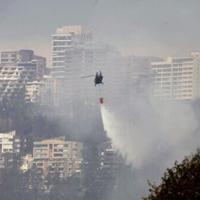A surge of wildfires, fueled by extreme drought attributed to climate change and deforestation, is wreaking havoc across South America.
These fires have resulted in the deaths of at least 30 individuals, enveloped cities in toxic smoke, and caused significant economic losses.
This year’s fire season is unlike the 2019 season that devastated forests in Brazil, Peru, and Bolivia, as pointed out by Brazilian environmentalist Erika Berenguer, a researcher at Oxford University.
Previously, rainfall helped extinguish fires primarily started by farmers in Brazil taking advantage of lenient laws to clear land for agriculture and livestock.
However, this year, South America is facing a severe drought. The Amazon basin, typically one of the wettest regions on Earth, is currently experiencing the worst fires in almost 20 years, according to the EU’s Copernicus observatory.
Berenguer attributed the increased flammability of the Amazon to climate change.
– Severity of the fires –
Between January 1 and September 26, over 400,000 fires have been recorded across South America, according to Brazil’s National Institute for Space Research (INPE).
“In nine months, we have already exceeded the number of outbreaks recorded in all of 2023,” noted Berenguer.
In Brazil, the fires have consumed 40.2 million hectares (99 million acres) of vegetation this year, well above the average of 31 million hectares in the last decade, according to Copernicus.
Several firefighters have lost their lives while on duty, as reported by local media.
In Ecuador, the mayor of Quito declared the city was “under attack” by 27 fires that led to the evacuation of over 100 families before being contained.
Ecuador and Peru have declared emergencies in various provinces, with 21 individuals in Peru losing their lives to fires since July, primarily small-scale farmers.
Fires are also raging in Argentina and Colombia.
– Causes of the fires –
Experts and authorities attribute the fires to a mix of factors, including droughts worsened by climate change and slash-and-burn agriculture.
Ecuadoran Environment Minister Ines Manzano stated, “It’s a clear example of climate change. If anyone thought it didn’t exist, well look, here it is.”
In countries like Peru and Bolivia, some fires are believed to have been ignited by farmers clearing land for cultivation, a common practice tolerated by authorities.
In the Brazilian Amazon, fires started by farmers and the agribusiness sector to clear forests for agriculture were exacerbated by the severe drought.
President Luiz Inacio Lula da Silva considers most fires to have criminal origins.
Arsonists have also been responsible for igniting fires in some regions.
Individuals have been arrested on suspicion of starting fires maliciously in countries like Argentina and Brazil.
– Impact on people –
The fires have significantly diminished air quality in various cities.
Sao Paulo was ranked the most polluted city globally in early September, with the smoke reaching cities as far as Montevideo and Buenos Aires.
Residents in many Brazilian cities are experiencing respiratory issues and eye irritation due to the smoke.
Bolivia’s health authorities recommend wearing face masks due to poor air quality.
The fires have also caused significant economic losses, with Brazil’s agricultural sector alone suffering $2.7 billion in damages.
In Ecuador, over 45,000 farm animals have died due to prolonged drought.
– Government response –
Thousands of firefighters and soldiers have been mobilized to combat the fires.
Berenguer emphasized the need for preventive measures against fires, advocating for stricter regulations against deforestation and greenhouse gas emissions to combat climate change.
burs-jss/cb/mlr/acb





